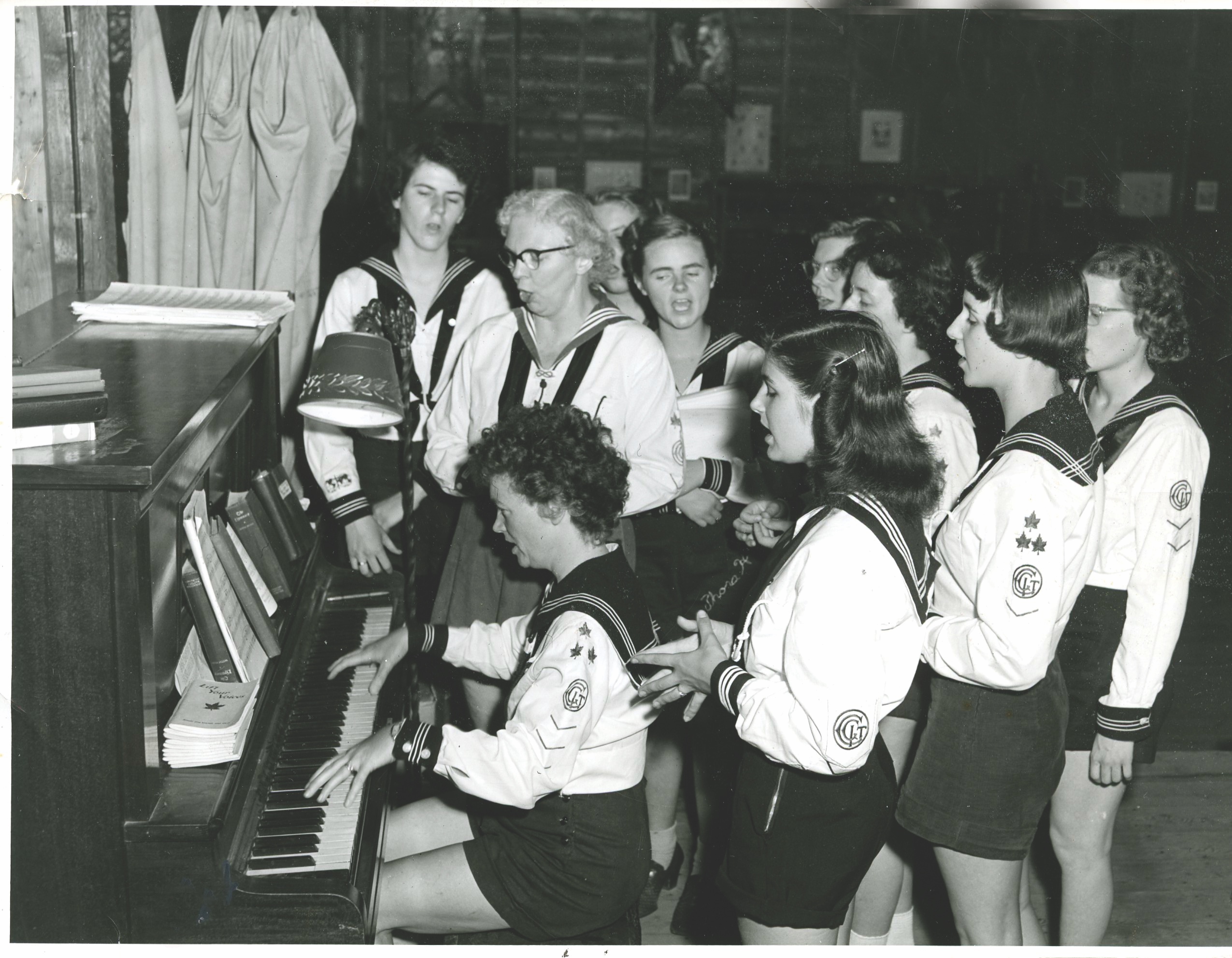As a former member of the Canadian Girls in Training, and now a leader and committee member, I have been directly involved in CGIT almost half of my life. However, with my mom and grandma both being involved with the organization well before my time, I have always been affected in some way by the CGIT community. And that’s what CGIT is: a community. We all bring something different to the group, but somehow we all still work together like a family.
As a CGIT member, you get used to a lot of things: uniforms, public speaking and, in general, the rollicking chaos that seems to preside over most of our meetings. Another thing you get used to very quickly is being asked what CGIT is. Maybe it was the middies we wore, but whenever we were out in public, it was a sure bet that someone was going to ask us who we were. Like most girls, I developed a standard answer, one that didn’t require too much effort: “CGIT is a Christian group for girls between the ages of 12 and 17.” It wasn’t until my final year as a member of the Regina group that I realized my standard response was far from the truth. CGIT is so much more than that.
You may unsubscribe from any of our newsletters at any time.
While CGIT behaves like a living organism, adapting with the changing times, it’s also a group that has a firm foundation. This year, CGIT is celebrating its 100th anniversary — that’s a century of history, stories and community.
Founded in 1915 by the YWCA with support from the Methodist, Presbyterian, Anglican and Baptist churches, CGIT was created to promote Christian education for girls aged 12 to 17. The organization was seen as a counterpoint to both the growing number of boys’ groups and the Girl Guides, which had migrated to Canada from the United Kingdom in 1910. Though the YWCA initially supported Guiding, it was later considered too competitive, too prescriptive, too authoritarian and too lacking in Christian education.
“Girls’ work, according to [their] theories, was best done in self-governed groups under the direction of an adult leader” who would help the girls draw up their own program, writes historian Patricia Dirks in Framing Our Past. This idea is still central to CGIT today.
Following an intensive study of girls’ interests and needs, the founding committee published, in 1916, Canadian Girls in Training: Suggestions for the Mid-Week Meetings of Sunday School Classes, Clubs, etc., for Teen-age Girls. The five-cent booklet was so popular with church youth leaders that “Canadian Girls in Training” soon became the organization’s name.
By 1920, the CGIT movement was flourishing on its own, so the YWCA withdrew support.
The organization had regional, provincial and national oversight bodies in place and groups in churches right across Canada. By 1933, there were 40,000 members in 1,100 groups. Three years later, CGIT materials were being used in Japan, Bermuda, China, Trinidad and parts of Africa.
As the organization grew and evolved, so too did its activities — many of which have become longstanding traditions. The first CGIT camp was held in Lumsden, Sask., in 1918. The first camp council (a leadership development camp for senior girls) was held 10 years later in Alberta. National CGIT Week was celebrated for the first time in 1937; the first national Christmas vesper service was presented in 1940.
The Anglican Church, which had always been lukewarm on CGIT, withdrew its support in 1946. The following year, CGIT came under the direction of the Canadian Council of Churches. Then, in the mid-1970s, it became an independent ecumenical body with support from The United Church of Canada, the Presbyterian Church in Canada and Canadian Baptist Ministries — an arrangement that continues to this day.
Throughout my years with CGIT, I’ve come to realize that to be a part of the group, you have to be willing to take risks. For example, I know of few other organizations that would take a group of girls and put them on a plane from Regina to Ontario only to attend a weekend jamboree. But that’s exactly what our leaders did. Three leaders and six girls made the three-hour plane trip with the sole intention of camping at Lambton United Church Centre on Lake Huron. From what I remember, the trip went well; we got lost twice, and there were only about seven traffic violations. But at the end of the weekend, we all ended up back on the plane home.
I wish I could say that every event we organized or participated in went as smoothly. In fact, the term “organized chaos” is a better description of the Regina group in my time. If you were to enter the basement of Zion United on a Wednesday between 7 and 9 p.m., you might have witnessed a group of girls pretending to be boats, or the furious chopping of vegetables to make antipasto (none of us are completely sure who actually liked the stuff). And you more than likely would have heard hysterical laughter. On occasion, you wouldn’t have found us in the basement, but rather out water sliding, Christmas shopping for a disadvantaged family or even on a scavenger hunt with a charitable twist. We were an energetic group of girls, and somehow our leaders kept pace.
As much as we loved fun and games, we did have a more serious side, one that that came out when we did mission study or learned about the political and social situation in Nepal, the global scarcity of clean water or the unjust treatment of women the world over. We’ve raised money for a centre for eating disorders, for a local street mission, for trees in Haiti and for water projects in developing countries. We’ve helped with Christmas gift-wrapping at the Regina food bank and sold hot dogs to support the Shyanne Parsons Foundation, started by a CGIT alumna to provide scholarships for future eye specialists.
Inevitably, things in our own lives went wrong, and it was in those moments when the true spirit of CGIT shone through. Whether one of us needed a listening ear, a shoulder to cry on or help to solve a problem, we would come together as one big ragtag family to support each other. Our leaders weren’t afraid to talk about what was real and about life’s ups and downs. While CGIT celebrates the joys, it also provides a support system when life is at its lowest.
CGIT’s purpose is “to cherish health, seek truth, know God, serve others and thus, with His help, become the girl God would have me be.” CGIT is a lifestyle, not just a mid-week activity. For me, CGIT is also family — there for me when my life shattered, ready to pick up the pieces; there for me when incredible things happened, ready to celebrate. That constant, dependable, loving presence is what CGIT is all about.
Admittedly, the organization, like so many of its kind, is dwindling, with only about 150 members in 20 or so groups across six regions. This 100th anniversary will likely be our last big celebration as an organization. It saddens me that future generations may not experience the organization as I have. CGIT has helped to shape me into the woman I have become today and has provided me with some of the strongest bonds of friendship I’ll ever know. I am proud to belong to a community with a history as rich and as long as CGIT.
Whether you belonged to one of the first CGIT groups or you only joined recently, there is something intangible that ties every girl, every leader and all the alumnae together. Times and circumstances change, but the CGIT spirit will always be there, encouraging us to maybe one day become the people that God would have us be.
***
This story first appeared in The United Church Observer’s June 2015 issue with the title “The girl God would have me be.”














